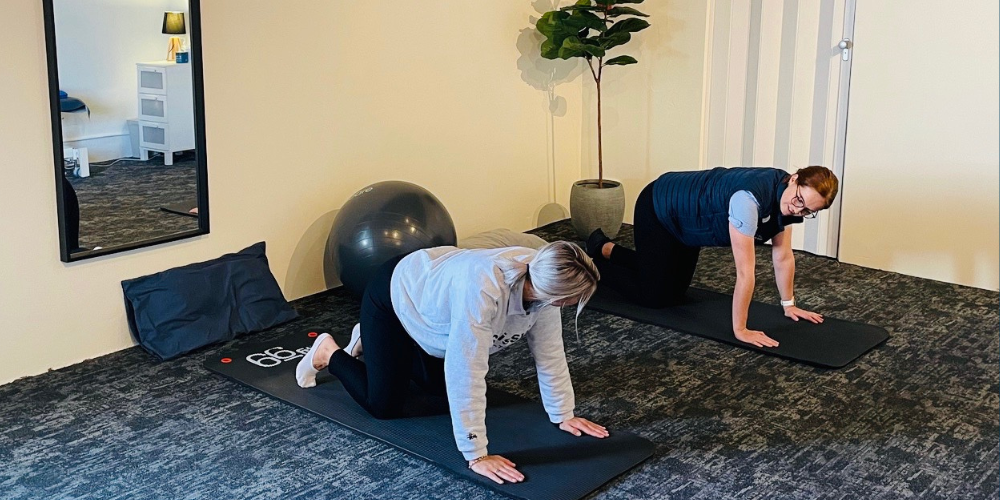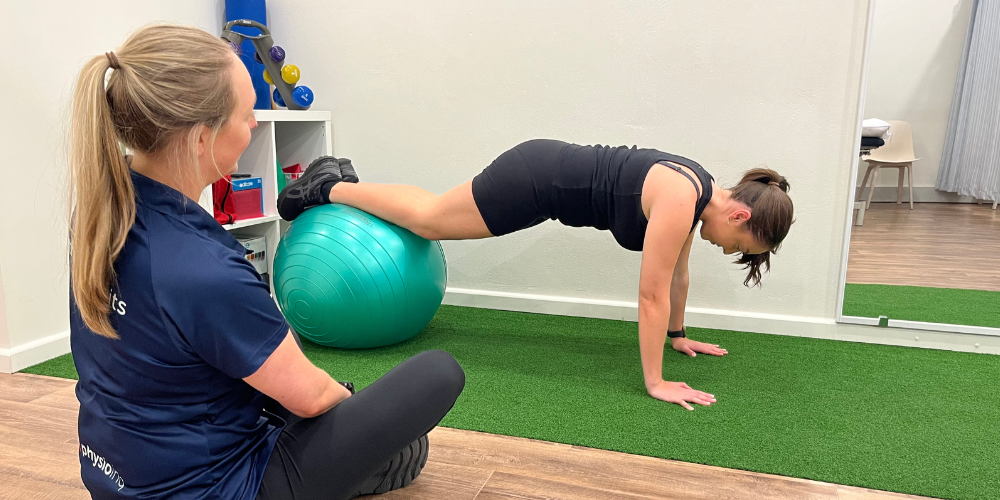Exercise for Pregnancy
Wednesday, August 2, 2023
Today we’ll be talking about the role of exercise in pregnancy, answering your questions about is it safe to exercise in pregnancy?
What are the guidelines for exercise during pregnancy? What exercises should be avoided during pregnancy? A major part of the role of a Women’s Health Physiotherapist is prenatal care including exercise, and prevention and management including through exercise of pelvic floor and musculoskeletal dysfunction related to pregnancy.
Benefits of exercise during pregnancy
Exercise throughout pregnancy can reduce the risk of:
- Gestational diabetes mellitus by 38%
- Gestational hypertension by 39%
- Pre-eclampsia by 41%
- The risk of developing depression during pregnancy
- The severity of depressive symptoms during pregnancy
Is it safe to exercise in pregnancy?
RECOMMENDATION 1: Women without contra-indications should participate in regular aerobic and strength conditioning exercise during pregnancy.
RECOMMENDATION 2: Women should be advised that there is no evidence that regular exercise during an uncomplicated pregnancy is detrimental to the woman or fetus.
RECOMMENDATION 3: Assessment of medical and obstetric risks should be undertaken to identify potential contra-indications to exercise for the pregnant woman prior to commencing an exercise program.
RECOMMENDATION 4: Exercise prescription for the pregnant woman requires appropriate consideration of the frequency, intensity, duration and mode of exercise.
RECOMMENDATION 5: Exercise prescription for the pregnant woman should consider her baseline level of fitness and exercise experience.
RECOMMENDATION 6: Exercise prescription for the pregnant woman should take into account the physiological adaptations to pregnancy and consider the gestation at which it is prescribed.
(From Royal Australian and New Zealand College of Obstetricians and Gynaecologists)

What are the physiological adaptations that happen during pregnancy?
- Vascular changes, ie decrease in blood pressure
- Cardiac changes, ie increase in cardiac output
- Haematological changes, ie increasing blood volume and anticoagulants
- Respiratory changes, ie resting oxygen increased
- Chest Wall changes, ie diaphragmatic elevation
- Gastrointestinal changes, ie movement, as well as progesterone levels, result in relaxation of muscle
- Skeletal / bone changes, ie temporary bone loss, increased lumbar lordosis (sway back), forward neck flexion and downward movement of the shoulders
- Body mass / weight changes, approx. 13kg, consisting of:
- Foetus: 3.5kg
- Uterine enlargement: 900g
- Amniotic Fluid: 800g
- Placenta: 600g
- Breast growth: 500g
- Increased Blood Vol 1.2kg
- Extracellular Fluid 1.2kg
- Fat Deposits 4.0kg (variable depending on pre pregnancy levels
What are the guidelines for exercise during pregnancy?
- An accumulation of 150-300 minutes of physical activity per week
- 30-60 minutes of moderate-intensity physical activity on most, and preferably all days of the week
Moderate intensity means you can pass the “talk test”, ie you can comfortably hold a conversation (60-80% of maximal aerobic capacity), and your temperature goes up only 1.5 degrees.
This might include brisk walking, stationary bike, swimming, strengthening exercises including squats, prenatal yoga and Pilates, or any physical activities including dancing that you did prior to your pregnancy.
Speak to your Women’s Health GP or Women’s Health Physiotherapist to get important and specific pelvic floor exercises.
What exercises should be avoided during pregnancy?
- Exercises with high abdominal pressure (eg weight lifting)
- Contact or collision sports (ice hockey, martial arts, soccer)
- Sports involving hard projectile objects or striking implements (eg cricket)
- Sports with risk of falling (skiing, skating, horse-riding)
- Sports requiring extreme balance (gymnastics, water skiing)
- Sports with significant changes in pressure (scuba diving, sky diving)
- High intensity training at altitudes > 2000m
- Exercises in the supine position
What are the potential contra-indications to exercise during pregnancy?
Assessment of these risks should be undertaken prior to commencing an exercise program:
- Previous spontaneous abortion
- Previous preterm birth or rupture of membrane
- Mild/moderate cardiovascular or respiratory disorder
- Anaemia
- Twin pregnancy > 28th week
- Extremely overweight/obese
- Intrauterine growth restriction in current pregnancy
- Malnutrition or eating disorder
- Foetal growth restriction
- Poorly controlled thyroid disease
- Persistent bleeding
- Placenta praevia
- Pre-eclampsia
- Pregnancy-induced hypertension
- History of premature labour contractions
- Shortened cervical length

Absolute contra-indications to exercise during pregnancy are:
- Incompetent cervix
- Growth restricted foetus
- High-order multiple gestation (>triplets)
- Placenta praevia after 28th week
- Ruptured membranes (waters broken)
- Signs of preterm labour > regular, painful contractions
- Hypertensive disorders of pregnancy
At Physio Inq Engadine, our Physiotherapists can help with a variety of pregnancy concerns, and can help to keep or even start you being active during this important time of your life. Contact us today.
Other useful resources
- What is Women's Health Physiotherapy
- Returning to running after pregnancy
- What exercise should I be doing during the third trimester of my pregnancy?
- Third trimester pain and weakness
- Abdominal separation in pregnancy
- Pregnancy 101 - How your body changes during pregnancy
- 10 ways to decrease pelvic pain in pregnancy
![]() Written on behalf of Physio Inq Engadine
Written on behalf of Physio Inq Engadine
